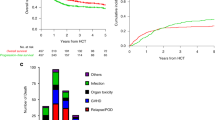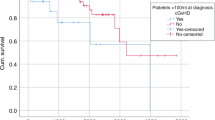Abstract
Hematopoietic cell transplantation (HCT) has become an established standard of care for many older patients with hematologic malignancies. The effect of transplantation on the quality of life (QOL) of older patients, however, has not been well studied. We thus analyzed QOL in patients ⩾60 undergoing an allogeneic HCT compared with patients <60 years. Prospective psychometric instruments were administered to 351 patients who underwent HCT from 2003 to 2010. Psychometric data were assessed longitudinally by validated questionnaires: Functional Assessment of Cancer Therapy-Bone Marrow Transplant (FACT-BMT), Coping Inventory and the Profile of Mood State-Short Form. Patients ⩾60 reported better social (P=0.006) and functional well-being (P=0.05) with FACT assessment, and had better total scores, (P=0.043) across all time points. When adjusted for baseline QOL scores as a covariate, social well-being remained significantly better, whereas the other scores became non-significant. With a median follow-up of 49 months, there were no significant differences in OS, relapse-free survival, relapse or chronic GVHD. This study provides further evidence that advanced age should not be a barrier in the decision to pursue allogeneic HCT. Older patients achieved comparable QOL when compared with younger patients.
This is a preview of subscription content, access via your institution
Access options
Subscribe to this journal
Receive 12 print issues and online access
$259.00 per year
only $21.58 per issue
Buy this article
- Purchase on Springer Link
- Instant access to full article PDF
Prices may be subject to local taxes which are calculated during checkout


Similar content being viewed by others
References
Lim Z, Brand R, Martino R, van Biezen A, Finke J, Bacigalupo A et al. Allogeneic hematopoietic stem-cell transplantation for patients 50 years or older with myelodysplastic syndromes or secondary acute myeloid leukemia. J Clin Oncol 2010; 28: 405–411.
Storb R . Reduced-intensity conditioning transplantation in myeloid malignancies. Curr Opin Oncol 2009; 21: S3–S5.
Artz AS . From biology to clinical practice: aging and hematopoietic cell transplantation. Biol Blood Marrow Transplant 2012; 18: S40–S45.
Alyea EP, Kim HT, Ho V, Cutler C, DeAngelo DJ, Stone R et al. Impact of conditioning regimen intensity on outcome of allogeneic hematopoietic cell transplantation for advanced acute myelogenous leukemia and myelodysplastic syndrome. Biol Blood Marrow Transplant 2006; 12: 1047–1055.
Aoudjhane M, Labopin M, Gorin NC, Shimoni A, Ruutu T, Kolb HJ et al. Comparative outcome of reduced intensity and myeloablative conditioning regimen in HLA identical sibling allogeneic haematopoietic stem cell transplantation for patients older than 50 years of age with acute myeloblastic leukaemia: a retrospective survey from the Acute Leukemia Working Party (ALWP) of the European group for Blood and Marrow Transplantation (EBMT). Leukemia 2005; 19: 2304–2312.
Gupta V, Kroger N, Aschan J, Xu W, Leber B, Dalley C et al. A retrospective comparison of conventional intensity conditioning and reduced-intensity conditioning for allogeneic hematopoietic cell transplantation in myelofibrosis. Bone Marrow Transplant 2009; 44: 317–320.
Luger SM, Ringden O, Zhang MJ, Perez WS, Bishop MR, Bornhauser M et al. Similar outcomes using myeloablative vs reduced-intensity allogeneic transplant preparative regimens for AML or MDS. Bone Marrow Transplant 2012; 47: 203–211.
Ringden O, Labopin M, Ehninger G, Niederwieser D, Olsson R, Basara N et al. Reduced intensity conditioning compared with myeloablative conditioning using unrelated donor transplants in patients with acute myeloid leukemia. J Clin Oncol 2009; 27: 4570–4577.
Shimoni A, Hardan I, Shem-Tov N, Yeshurun M, Yerushalmi R, Avigdor A et al. Allogeneic hematopoietic stem-cell transplantation in AML and MDS using myeloablative versus reduced-intensity conditioning: the role of dose intensity. Leukemia 2006; 20: 322–328.
Gupta V, Panzarella T, Li L, Khan J, Sharma A, Lipton JH et al. A prospective study comparing the outcomes and health-related quality of life in adult patients with myeloid malignancies undergoing allogeneic transplantation using myeloablative or reduced-intensity conditioning. Biol Blood Marrow Transplant 2012; 18: 113–124.
Lazaryan A, Hamilton BK, McLellan L, Rybicki L, Foster L, Cooper M et al. Comparison of quality of life outcomes and psychosocial fFunctioning between patients undergoing myeloablative or reduced-intensity allogeneic hematopoietic stem cell transplantation for myeloid mMalignancies. Blood 2011; 118: 385–385.
Wong R, Giralt SA, Martin T, Couriel DR, Anagnostopoulos A, Hosing C et al. Reduced-intensity conditioning for unrelated donor hematopoietic stem cell transplantation as406 treatment for myeloid malignancies in patients older than 55 years. Blood 2003; 102: 3052–3059.
Bertz H, Potthoff K, Finke J . Allogeneic stem-cell transplantation from related and unrelated donors in older patients with myeloid leukemia. J Clin Oncol 2003; 21: 1480–1484.
Mohty M, de Lavallade H, Ladaique P, Faucher C, Vey N, Coso D et al. The role of reduced intensity conditioning allogeneic stem cell transplantation in patients with acute myeloid leukemia: a donor vs no donor comparison. Leukemia 2005; 19: 916–920.
Mohty M, de Lavallade H, El-Cheikh J, Ladaique P, Faucher C, Furst S et al. Reduced intensity conditioning allogeneic stem cell transplantation for patients with acute myeloid leukemia: long term results of a 'donor' versus 'no donor' comparison. Leukemia 2009; 23: 194–196.
Estey E, de Lima M, Tibes R, Pierce S, Kantarjian H, Champlin R et al. Prospective feasibility analysis of reduced-intensity conditioning (RIC) regimens for hematopoietic stem cell transplantation (HSCT) in elderly patients with acute myeloid leukemia (AML) and high-risk myelodysplastic syndrome (MDS). Blood 2007; 109: 1395–1400.
Kroger N . Allogeneic stem cell transplantation for elderly patients with myelodysplastic syndrome. Blood 2012; 119: 5632–5639.
McClune BL, Weisdorf DJ, Pedersen TL, Tunes da Silva G, Tallman MS, Sierra J et al. Effect of age on outcome of reduced-intensity hematopoietic cell transplantation for older patients with acute myeloid leukemia in first complete remission or with myelodysplastic syndrome. J Clin Oncol 2010; 28: 1878–1887.
Bolwell BJ . Are predictive factors clinically useful in bone marrow transplantation? Bone Marrow Transplantation 2003; 32: 853–861.
Alatrash G, de Lima M, Hamerschlak N, Pelosini M, Wang X, Xiao L et al. Myeloablative reduced-toxicity i.v. busulfan-fludarabine and allogeneic hematopoietic stem cell transplant for patients with acute myeloid leukemia or myelodysplastic syndrome in the sixth through eighth decades of life. Biol Blood Marrow Transplant 2011; 17: 1490–1496.
McQuellon RP, Russell GB, Cella DF, Craven BL, Brady M, Bonomi A et al. Quality of life measurement in bone marrow transplantation: development of the Functional Assessment of Cancer Therapy-Bone Marrow Transplant (FACT-BMT) scale. Bone Marrow Transplant 1997; 19: 357–368.
Carver CS . You want to measure coping but your protocol's too long: consider the brief COPE. Internatl J Behav Med 1997; 4: 92–100.
Baker F, Denniston M, Zabora J, Polland A, Dudley WN . A POMS short form for cancer patients: psychometric and structural evaluation. Psycho-oncology 2002; 11: 273–281.
Giralt S, Ballen K, Rizzo D, Bacigalupo A, Horowitz M, Pasquini M et al. Reduced-intensity conditioning regimen workshop: defining the dose spectrum. Report of a workshop convened by the center for international blood and marrow transplant research. Biol Blood Marrow Transplant 2009; 15: 367–369.
Sorror ML, Maris MB, Storb R, Baron F, Sandmaier BM, Maloney DG et al. Hematopoietic cell transplantation (HCT)-specific comorbidity index: a new tool for risk assessment before allogeneic HCT. Blood 2005; 106: 2912–2919.
Bolwell B, Sobecks R, Pohlman B, Andresen S, Rybicki L, Kuczkowski E et al. A prospective randomized trial comparing cyclosporine and short course methotrexate with cyclosporine and mycophenolate mofetil for GVHD prophylaxis in myeloablative allogeneic bone marrow transplantation. Bone Marrow Transplant 2004; 34: 621–625.
Baker F, Denniston M, Smith T, West MM . Adult cancer survivors: how are they faring? Cancer 2005; 104: 2565–2576.
Chevallier P, Szydlo RM, Blaise D, Tabrizi R, Michallet M, Uzunov M et al. Reduced-intensity conditioning before allogeneic hematopoietic stem cell transplantation in patients over 60 years: a report from the SFGM-TC. Biol Blood Marrow Transplant 2012; 18: 289–294.
Koreth J, Aldridge J, Kim HT, Alyea EP 3rd, Cutler C, Armand P et al. Reduced-intensity conditioning hematopoietic stem cell transplantation in patients over 60 years: hematologic malignancy outcomes are not impaired in advanced age. Biol Blood Marrow Transplant 2010; 16: 792–800.
Wong FL, Francisco L, Togawa K, Bosworth A, Gonzales M, Hanby C et al. Long-term recovery after hematopoietic cell transplantation: predictors of quality-of-life concerns. Blood 2010; 115: 2508–2519.
Lee SJ, Kim HT, Ho VT, Cutler C, Alyea EP, Soiffer RJ et al. Quality of life associated with acute and chronic graft-versus-host disease. Bone Marrow Transplant 2006; 38: 305–310.
Williams LA, Giralt SA, Wang XS, Mobley GM, Mendoza TR, Cohen MZ et al. Measuring the symptom burden of allogeneic hematopoietic stem cell transplantation in patients with and without acute graft-versus-host disease. Biol Blood Marrow Transplant 2009; 15: 20–21.
Blaise D, Tabrizi R, Boher JM, Le Corroller-Soriano AG, Bay JO, Fegueux N et al. Randomized study of 2 reduced-intensity conditioning strategies for human leukocyte antigen-matched, related allogeneic peripheral blood stem cell transplantation: prospective clinical and socioeconomic evaluation. Cancer 2013; 119: 602–611.
Lee SJ, Fairclough D, Parsons SK, Soiffer RJ, Fisher DC, Schlossman RL et al. Recovery after stem-cell transplantation for hematologic diseases. J Clin Oncol 2001; 19: 242–252.
Pidala J, Anasetti C, Jim H . Quality of life after allogeneic hematopoietic cell transplantation. Blood 2009; 114: 7–19.
Altmaier EM, Ewell M, McQuellon R, Geller N, Carter SL, Henslee-Downey J et al. The effect of unrelated donor marrow transplantation on health-related quality of life: a report of the unrelated donor marrow transplantation trial (T-cell depletion trial). Biol Blood Marrow Transplant 2006; 12: 648–655.
Acknowledgements
We thank the transplantation team at the Cleveland Clinic Taussig Cancer Institute for their contributions, and all our patients for their participation. We thank Navneet Majhail MD, MS for his constructive review of the manuscript.
Author information
Authors and Affiliations
Corresponding author
Ethics declarations
Competing interests
The authors declare no conflict of interest.
Additional information
Supplementary Information accompanies this paper on Bone Marrow Transplantation website
Supplementary information
Rights and permissions
About this article
Cite this article
Hamilton, B., Rybicki, L., Dabney, J. et al. Quality of life and outcomes in patients⩾60 years of age after allogeneic hematopoietic cell transplantation. Bone Marrow Transplant 49, 1426–1431 (2014). https://doi.org/10.1038/bmt.2014.166
Received:
Revised:
Accepted:
Published:
Issue Date:
DOI: https://doi.org/10.1038/bmt.2014.166
This article is cited by
-
Patient preferences for allogeneic haematopoietic stem cell transplantation: how much benefit is worthwhile from the patient’s perspective?
Supportive Care in Cancer (2021)
-
Translation and validation of the Functional Assessment of Cancer Therapy-Bone Marrow Transplant (FACT-BMT) version 4 quality of life instrument into Arabic language
Health and Quality of Life Outcomes (2018)
-
Psychological distress, chronic conditions and quality of life in elderly hematologic cancer patients: study protocol of a prospective study
BMC Cancer (2017)
-
Influence of melphalan plus fludarabine-conditioning regimen in elderly patients aged ⩾55 years with hematological malignancies
Bone Marrow Transplantation (2016)
-
Process of allogeneic hematopoietic cell transplantation decision making for older adults
Bone Marrow Transplantation (2016)



